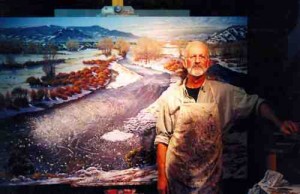Essay by Gail Binkly
Outdoors – September 2003 – Colorado Central Magazine
WHEN I READ that the Outdoor Industry Association threatened to move its biannual gear show out of Salt Lake City as a protest against Utah’s wilderness policies, I was taken aback. Not by the announcement, but by the reported magnitude of the show: 15,000 visitors spending $24 million in the region to pore over high-tech gear.
When, I wondered, did we decide that going outdoors takes so much money?
Catalogs clutter my mailbox daily, featuring endless pages of pricey items purportedly needed for forays into the wild. Hikers and backpackers are urged to hit the trail with sun-blocking clothing, moisture-wicking socks, waterproof roll-up hats, anti-shock hiking poles, and distortion-free sunglasses — not to mention a handheld Global Positioning System, and, soon, remote locator-beacons.
We can tote portable camp chairs, lightweight cooking pots and pre-packaged gourmet meals, and sleep in snazzy tents boasting vestibules, sun roofs, and climate-controlled doors.
It’s free enterprise in action — but something seems amiss when a hiker’s clothes and accessories cost more than a fashion model’s.
My original camping set-up was scarcely a cut above Flint McCullough’s bedroll in Wagon Train. The first piece of equipment I bought, back in the early ’80s, was a two-person dome tent for $19.95. Along with cheap sleeping bags and foam ground pads, it allowed me and my beloved the luxury of sojourning in the backcountry.
The well-heeled would have laughed to see us stumbling across the Sonoran Desert at sunset, searching for a cozy campsite while clutching in our arms (we didn’t even have backpacks) our bulky, bright-green sleeping bags, our equally lurid ground pads, and the tent.
But the modest shell went up quickly and easily, and I never felt more secure than when tucked into a hollow of the desert, with the zipper shut tight against wandering rattlesnakes or scorpions.
Gradually, I came to believe the tent possessed magical protective qualities. It kept us dry in the Olympic rainforest and warm well into November. It sheltered us during one dazzlingly violent Sonoran thunderstorm, when lightning pounded the plain so closely all around us I expected each flash to be the last thing I saw.
Eventually, we felt the itch to upgrade our equipment. We acquired frame backpacks and better sleeping bags, both good investments. But the inflatable ground pads proved slippery and uncomfortable, so we returned to the indestructible old foam pads. Once, when stuck in a snowdrift on Wolf Creek Pass, I shoved one under a tire and gained enough traction to escape.
The tent likewise kept going and going — though it had close calls. It — and we — came within a few yards of destruction in a private campground on the Arizona-Mexico border.
I’d just dozed off when a distant siren woke me. It grew steadily louder, heading straight toward us.
Sitting up, I unzipped the “front door” to peer out. Two cars were racing through the campground, dodging the scattered tents and RVs. One was a police vehicle, lights flashing, siren still screaming. The other was a nondescript sedan. There was no time to run to safety, so I just watched, bemused. After a few wild seconds, the cars swept by us — just a few yards away — and roared out of sight.
MY HUSBAND slumbered through the entire episode. Indeed, in the morning he tried to convince me I’d imagined it all — until the campground owner told us the police had been chasing a stolen car whose driver had managed to jump a ditch into Mexico and escape.
This summer, the magical tent almost met its match at a primitive campsite in Big Bend, Texas, we had just erected and staked down the dome when a tremendous wind arose. Blinded by dust, we ducked into our car.
Gales tore at the 20-year-old tent, bending its rods nearly in two. It bowed and straightened, shuddered and ducked. It looked like a jellyfish dancing a jig.
“Time for a new tent,” my husband murmured. But when the storm abated, the dome was unscathed. The next morning we packed it up, ready for another excursion.
Edward Abbey believed mechanical gadgets tend to “separate a man from the world around him.” Flipping through ads in the latest outdoor magazine, I wonder: Could Abbey have written Desert Solitaire had he tromped the Southwest in zip-off nylon pants and foam-padded all-terrain hikers, instead of old boots and jeans? Does an obsession with costly gear tether us to the corporate world even as we try to escape it? Does it foster our image as moneyed dilettantes, instead of serious lovers of the wild?
All I know is that I’ve had some of the richest times of my life with some of the cheapest equipment. So I’ll forgo the outdoor retail show for now. But keep those catalogues coming — someday, my tent may wear out.
Gail Binkly is a contributor to Writers on the Range, a service of High Country News in Paonia, Colorado (www.hcn.org). She writes in Cortez, Colorado.

